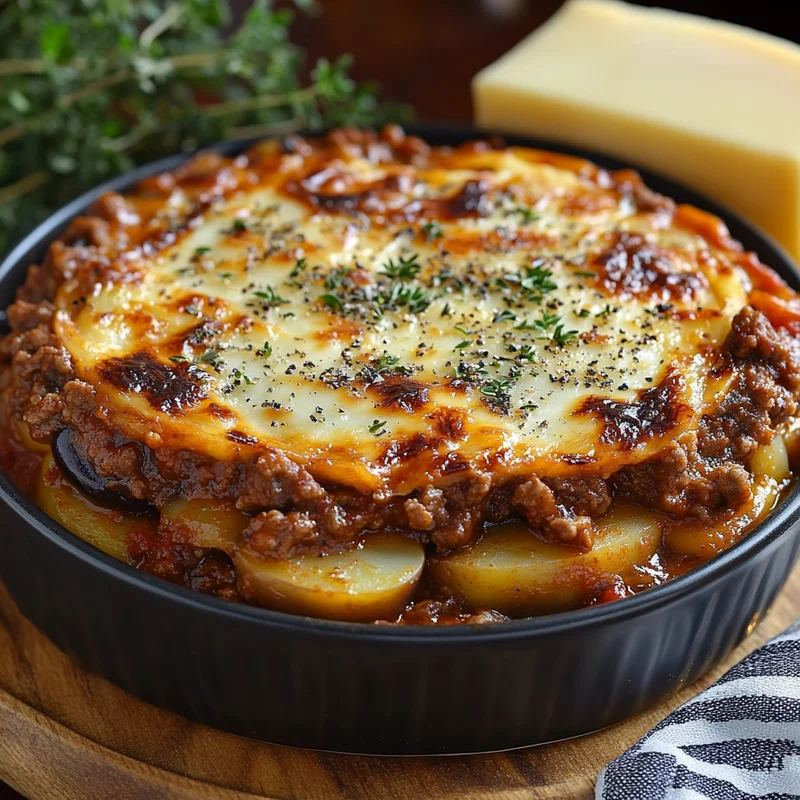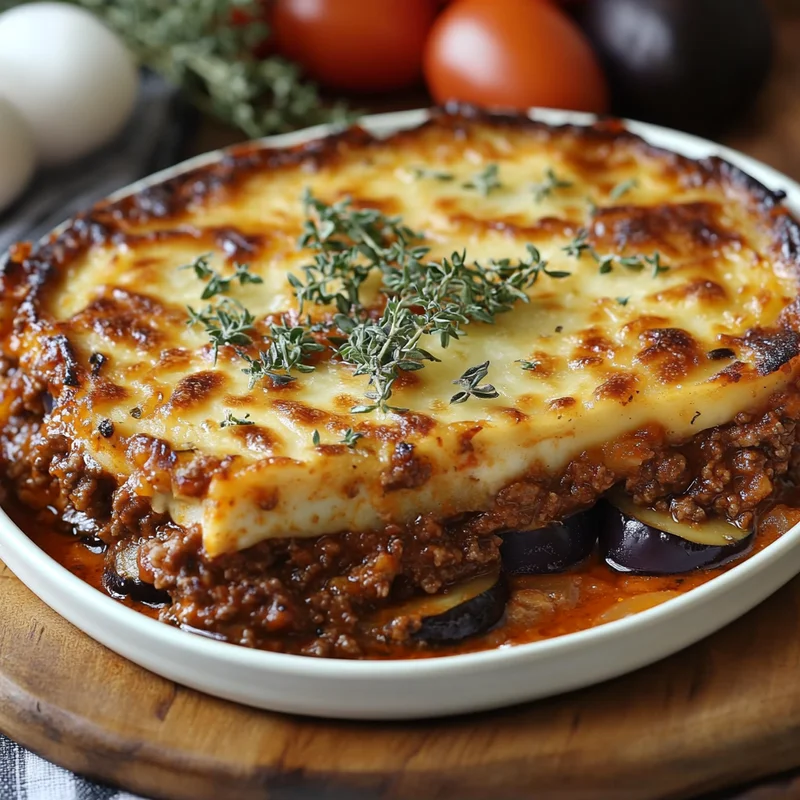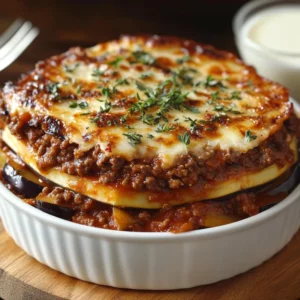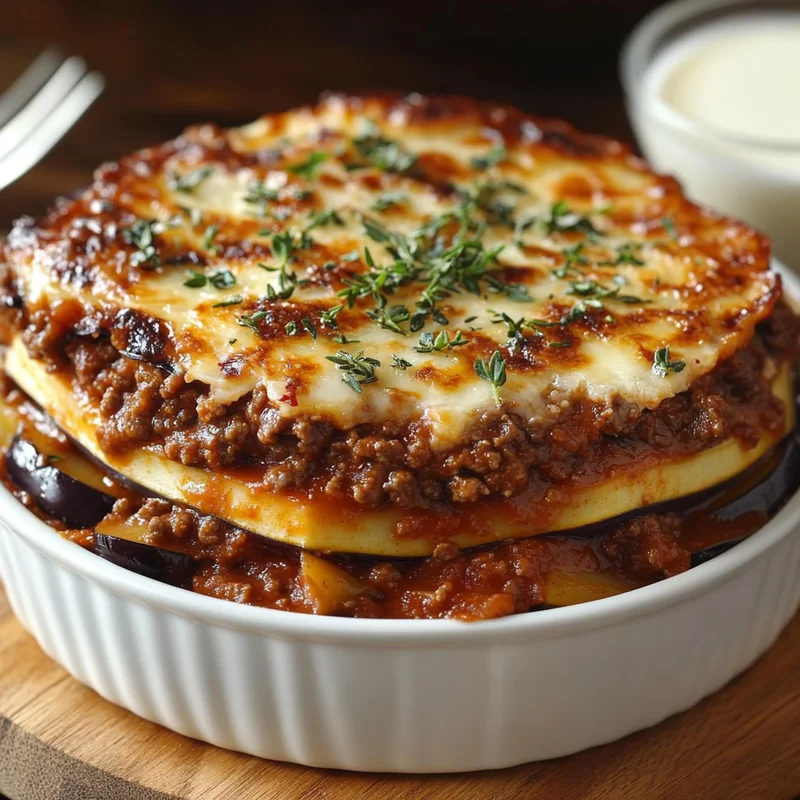Introduction
Oh boy, do I have a recipe for you today! Close your eyes for a second and imagine the smell of warm spices, savory meat, and creamy goodness wafting through your kitchen. That, my friends, is the magic of Traditional Greek Moussaka. This isn’t just dinner; it’s an experience, a journey straight to a sun-drenched taverna, even if you’re just in your own cozy home.
Making moussaka is often described as a labor of love, and maybe it is a little bit, but trust me, every single step is worth it. It’s the ultimate comfort food, perfect for a Sunday supper, a special occasion, or just when you need a big, warm hug on a plate. It’s the kind of dish that creates memories and always brings smiles to the table.
Why You’ll Love This Recipe
- Fast: Okay, maybe not fast in the speedy weeknight sense, but it’s efficient! Each layer comes together beautifully. (Let’s call it efficiently rewarding!)
- Easy: While there are a few components, none of them are tricky. If you can sauté, slice, and whisk, you’ve got this!
- Giftable: A pan of moussaka is one of the most thoughtful gifts you can give. It says “I care about you and your comfort!”
- Crowd-pleasing: Seriously, who doesn’t swoon over a perfectly layered, cheesy, saucy moussaka? It’s a guaranteed hit!

Ingredients
Gather ’round, let’s talk about the stars of our show. You’ll need:
- Beef mince meat (1 kg): The hearty base of our savory meat sauce.
- Eggplants (4): Those gorgeous purple beauties! They absorb flavors like a dream.
- Potatoes (4): Adding a lovely, soft bottom layer.
- Zucchini (4): For an extra layer of tender veggie goodness.
- Large Red onion (1): The aromatic start to our sauce.
- Medium-sized bulb Garlic (1): Because everything is better with garlic!
- Fresh Parsley (1 bunch): For freshness and flavor in the meat sauce.
- Bay leaves (3): Adding that deep, traditional flavor to the simmer.
- Canned tomatoes (800 g): Crushed or diced work perfectly for the rich sauce.
- Oregano (1 tsp) & Thyme (1/2 tsp): Classic Greek herbs that bring the Mediterranean vibe.
- Olive oil (2 1/8 cups): You’ll need a good amount for frying those veggies to perfection. Use good quality oil!
- Salt (2 tbsp) & Pepper (1/2 tbsp White pepper): For seasoning every layer just right. White pepper in the béchamel is a classic touch.
- Cinnamon (1/2 tsp, ground) & Nutmeg (1 tsp, ground): Don’t skip these! They add that essential, warm, slightly sweet note that makes moussaka unique.
- Sugar (2 tsp): Just a pinch to balance the acidity of the tomatoes.
- Plain flour (1 cup) & Unsalted butter (150 g) & Milk (1 Litre): The trio for our silky, smooth béchamel sauce.
- Egg yolks (2): These make the béchamel extra rich and help it set beautifully.
- Kefalograviera cheese (450 g, finely shredded): This is the traditional Greek cheese – salty and tangy! If you can’t find it, finely shredded Parmesan is a fantastic and widely available substitute. Don’t skimp on the cheese!
How to Make It
Alright, let’s roll up our sleeves and get cooking! Making moussaka is a step-by-step process, building flavor and texture with each layer. Think of it as an assembly line of deliciousness.
First, you’ll want to prep those beautiful vegetables. The eggplant, zucchini, and potatoes need to be sliced and usually given a little love in some hot olive oil until they’re tender and slightly browned. This step is crucial for flavor and texture! Make sure to drain them well so your moussaka isn’t oily.
Next up is the heart of the dish: the rich meat sauce. You’ll sauté your finely chopped onion and garlic until fragrant, then brown the beef mince. Add in those canned tomatoes, fresh parsley, bay leaves, oregano, thyme, salt, pepper, a touch of sugar, and don’t forget the magic duo: cinnamon and nutmeg! Let this simmer gently, allowing all those incredible flavors to meld together into a thick, savory ragu.
While the meat sauce is simmering away, you’ll tackle the creamy béchamel sauce. This is easier than you might think! Start with melting the butter, whisk in the flour to make a smooth paste (a roux), and then gradually whisk in the milk until you have a thick, luxurious sauce. Season it with salt, white pepper, and a little more nutmeg. Off the heat, whisk in the egg yolks and a generous portion of your shredded cheese for extra richness and body.
Now comes the fun part: assembly! Find your trusty deep baking dish. You’ll typically start with a layer of potatoes, then maybe some eggplant and zucchini. Spoon over that glorious meat sauce. Add more layers of the fried vegetables, pressing gently. Finally, pour that smooth, cheesy béchamel sauce evenly over the top, spreading it right to the edges. Sprinkle with the remaining shredded cheese for that perfect golden crust.
Pop it in the oven and bake until the top is beautifully golden brown and bubbly, and the edges are gently pulling away. The smell that fills your kitchen will be absolutely divine!
Substitutions & Additions
- Meat: Ground lamb is also traditionally used in moussaka and is absolutely delicious. You could even do a mix of beef and lamb.
- Cheese: As mentioned, Parmesan is a great substitute for Kefalograviera. Pecorino Romano or a sharp aged cheddar could also work in a pinch, though they’ll change the flavor profile slightly.
- Veggies: Feel free to add layers of sautéed mushrooms, bell peppers, or even pre-cooked lentils if you want to make it heartier or adapt it.
- Spice: A pinch of red pepper flakes in the meat sauce can add a lovely subtle heat.

Tips for Success
- Prep Your Veggies Right: Eggplant is notorious for absorbing oil. After frying, lay the slices on paper towels to drain off excess oil. Some people salt the eggplant first to draw out moisture, rinse, and pat dry before frying – this helps prevent them from becoming greasy.
- Don’t Rush the Sauce: Let the meat sauce simmer for at least 30-40 minutes (or even longer!) to really develop deep flavors.
- Smooth Béchamel: Make sure your milk is at room temperature or slightly warm when you add it to the roux to prevent lumps. Whisk constantly!
- Let it Rest: This is key! Moussaka needs about 15-20 minutes to rest after coming out of the oven before you slice into it. This allows the layers to set beautifully so it doesn’t collapse when you serve it.
- Prep Ahead: You can make the meat sauce and fry the vegetables a day in advance. Store them separately in the fridge. Make the béchamel just before assembling and baking.
How to Store It
If you miraculously have leftovers (which is a big if!), moussaka stores beautifully. Let it cool completely before covering tightly with plastic wrap or transferring to airtight containers.
- Refrigerator: It will keep well in the fridge for 3-4 days.
- Freezer: You can freeze individual portions or even a whole assembled but unbaked moussaka. Wrap tightly in plastic wrap and then foil or place in a freezer-safe container. It will keep for up to 3 months. Thaw in the fridge overnight before reheating or baking.
- Reheating: Reheat individual portions gently in the microwave. To reheat a larger piece or a whole dish, cover with foil and warm in the oven at around 325°F (160°C) until heated through.
FAQs
Here are a couple of common questions I get asked about moussaka:
Q: Can I make this ahead of time?
A: Yes! You can prepare the meat sauce and the fried vegetables a day or two in advance. Store them separately in the fridge. Assemble and bake just before you want to serve.
Q: My moussaka turned out a little watery. What went wrong?
A: This usually happens if the vegetables (especially the eggplant) weren’t drained properly after frying, or if the meat sauce wasn’t reduced enough and was too liquidy. Make sure both layers are fairly “dry” before assembling.

Authentic Greek Moussaka
Equipment
- Deep baking dish
- large pan For sautéing and simmering sauce
- Pan For frying vegetables
- Saucepan For béchamel sauce
- Whisk
- paper towels For draining fried vegetables
Ingredients
Vegetables & Frying
- 4 Eggplants
- 4 Potatoes
- 4 Zucchini
- 2.125 cup Olive oil good quality, for frying and sautéing
Meat Sauce
- 1 kg Beef mince meat
- 1 Large Red onion
- 1 bulb Medium-sized Garlic
- 1 bunch Fresh Parsley
- 3 Bay leaves
- 800 g Canned tomatoes Crushed or diced
- 1 tsp Oregano
- 0.5 tsp Thyme
- 2 tsp Sugar
- 0.5 tsp Ground Cinnamon
- 1 tsp Ground Nutmeg
Béchamel Sauce
- 1 cup Plain flour
- 150 g Unsalted butter
- 1 Litre Milk
- 2 Egg yolks
- 1 tsp Nutmeg
Seasoning & Cheese
- 2 tbsp Salt For seasoning all layers
- 0.5 tbsp White pepper Especially for béchamel
- 450 g Kefalograviera cheese Finely shredded; Parmesan is a good substitute
Instructions
- Slice the eggplant, zucchini, and potatoes.
- Fry the sliced vegetables in hot olive oil until tender and slightly browned.
- Drain the fried vegetables well on paper towels to remove excess oil.
- Sauté the finely chopped red onion and garlic in some olive oil until fragrant.
- Add the beef mince and brown.
- Stir in the canned tomatoes, fresh parsley, bay leaves, oregano, thyme, salt, pepper, sugar, ground cinnamon, and nutmeg.
- Let the meat sauce simmer gently, allowing flavors to meld and the sauce to thicken.
- Melt the butter in a saucepan.
- Whisk in the plain flour to make a smooth paste (roux).
- Gradually whisk in the milk until you have a thick, luxurious sauce.
- Season the béchamel with salt, white pepper, and nutmeg.
- Remove from heat and whisk in the egg yolks and a generous portion of the shredded cheese.
- In a deep baking dish, layer the fried potatoes.
- Add layers of the fried eggplant and zucchini.
- Spoon the meat sauce evenly over the vegetable layers.
- Add more layers of the fried vegetables, pressing gently.
- Pour the smooth, cheesy béchamel sauce evenly over the top, spreading it right to the edges.
- Sprinkle with the remaining shredded cheese.
- Pop the dish in the oven and bake until the top is beautifully golden brown and bubbly.
- Let the moussaka rest for about 15-20 minutes after coming out of the oven before slicing.
Notes
- Ground lamb can be used instead of beef mince, or a mix of both.
- Parmesan is a great substitute for Kefalograviera cheese. Pecorino Romano or a sharp aged cheddar could also work but will change the flavor.
- Sautéed mushrooms, bell peppers, or pre-cooked lentils can be added as extra layers.
- A pinch of red pepper flakes can be added to the meat sauce for subtle heat. Tips for Success:
- After frying eggplant, drain slices on paper towels to remove excess oil. Salting eggplant first to draw out moisture, rinsing, and patting dry can also help prevent greasiness.
- Let the meat sauce simmer for at least 30-40 minutes (or longer) to develop deep flavors.
- Use room temperature or slightly warm milk for the béchamel sauce to prevent lumps. Whisk constantly.
- Resting the moussaka for 15-20 minutes after baking is crucial for the layers to set.
- The meat sauce and fried vegetables can be made a day in advance and stored separately in the fridge. Make the béchamel just before assembling and baking. Storage:
- Let leftovers cool completely. Cover tightly with plastic wrap or transfer to airtight containers.
- Refrigerate for 3-4 days.
- Freeze individual portions or a whole assembled but unbaked moussaka for up to 3 months. Thaw overnight in the fridge before reheating or baking.
- Reheat individual portions gently in the microwave. Reheat larger pieces or a whole dish covered with foil in the oven at around 325°F (160°C) until heated through.

